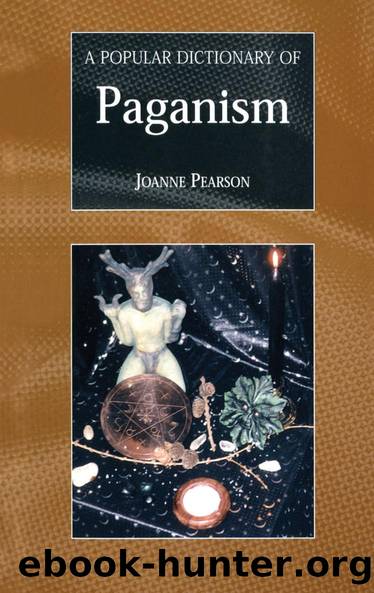A Popular Dictionary of Paganism by Joanne Pearson

Author:Joanne Pearson [Pearson, Joanne]
Language: eng
Format: epub
Tags: Body; Mind & Spirit, Reference, Dictionaries, Religion, Paganism & Neo-Paganism
ISBN: 9780700715916
Google: sSabzgEACAAJ
Publisher: RoutledgeCurzon
Published: 2002-01-15T04:52:18+00:00
M
Mabinogion The main repository in verse of Welsh Celtic oral tradition, the Four Branches of the Mabinogi make up part of the thirteenth century Red Book of Hergest. The Mabinogion contains a great deal of Celtic mythology, but only one of its mythological figures, Mabon (âDivine Youthâ), son of Modron, is to be found in inscriptions and place names (in the Romano-Celtic form, Maponus). Robert Graves suggested that Mabinogion means either âjuvenile romancesâ or âtales of the son of a virgin motherâ. Lady Charlotte Guestâs translation of 1848 is the best-known modern edition.
Mabon (âdivine youthâ) Son of Modron, in Welsh mythology. In North America, an alternative name for the Autumn Equinox. See also Mabinogion.
macrocosm The universe. The reflection of the macrocosm in the microcosm is a key Hermetic principal embedded within the magic and philosophy of the Western Esoteric Tradition and thence transferred to Wicca.
Maeve/Mab Queen of the Fairies in English tradition. Her name may derive from the Irish goddess queen Medb, but mab is the midwife of the fairies and mab in Welsh means baby.
magic Important in many types of Paganism, the practice of which is by no means a requisite for being Pagan. The difficulty in characterising Wicca and Paganism as religions has been exacerbated by the portrayal of magic as a contra-religious instrumental means of control rather than as a spiritual discipline which may be a constitutive part of group religious practice. Magic in Paganism is understood in the same way as it was portrayed in the Renaissance: it is not set in opposition to religion, but rather is an important element of spiritual growth towards the mystical attainment of gnosis, with any short-term pragmatic goals being secondary to this end result. In Paganism, magic is as much a group practice as individual, and forms an integral part of religion.
Magic tends to fall into three types. The first of these can be termed âlesserâ, ânaturalâ, or âhorizontalâ magic, and includes traditional concepts associated with witchcraft, for example chants, dances, and poppets. These isolated, specific spells may be performed separately from ritual or at the end of ritual, and tend to be time and place specific, immediate rather than continuous, goal orientated and pragmatic, for example a job spell. In this sense, magic is partly concerned with specific, concrete problems and is thus distinct from religious concerns with the fundamental issues of human existence.
The second magic could be termed âhigherâ, âritualâ or âverticalâ magic, or ceremonial magic. This type of magic tends to be performed as part of ritual (e.g. a kabbalistic ritual might be used to empower planetary talismans) and integrated into a whole system of correspondences. Though goal oriented, âverticalâ magic is less immediate and specific than âlowâ magic, tending towards the sequential and processual, magic performed as part of ongoing ritual continuity. This âhighâ magic can be practised separately from any particular religious belief system although, in Paganism, it tends to be integrated within both a religious and magical worldview.
The third magic is the magic of transmutation, the stripping away of layers and forging of the âTrue Willâ or pure self.
Download
This site does not store any files on its server. We only index and link to content provided by other sites. Please contact the content providers to delete copyright contents if any and email us, we'll remove relevant links or contents immediately.
The Practice of Classical Palmistry by Madame la Roux(410)
Predicting Your Future through Astrology by Sita Ram Singh(407)
How to Be Your Own Therapist by Owen O'Kane(386)
2021 Quantum Human Design Evolution Guide by Karen Curry Parker(309)
Magic of Isis: A Powerful Book of Incantations and Prayers by Alana Fairchild(300)
Yoga for Beginners: Your Natural Way to Strengthen Your Body, Calming Your Mind and Be in The Moment (Yoga Poses) (A Better You Book 1) by Susan Mori(294)
Writing Guide for Memorandum of Understanding by unknow(269)
Christmas Witch (Hot Hex 3) by Susan Stephens(255)
Tarot de Marseille by Marius Høgnesen & Paul Marteau(250)
Africa's Diabolical Entrapment: Exploring the Negative Impact of Christianity, Superstition and Witchcraft on Psychological, Structural and Scientific Growth in Black Africa! by Larr Frisky(249)
Learn Cold Reading: The real secret of mind readers by Reynolds Ethan(248)
Shadow Worlds by Andrew Wood(244)
The Enfield Poltergeist Tapes: One of the most disturbing cases in history. What really happened? by Melvyn J. Willin(240)
Design Guide to Learn Calligraphy: Fonts, Styles, Pens, Letters, & Numbers by Agatha Adams(237)
The Stuff of Dreams by Edward Lucas White(228)
Miracle Minded Manager by John Murphy(223)
The Watkins Tarot Handbook by Naomi Ozaniek(219)
The World's Most Mysterious Objects by Patricia Fanthorpe & Patricia Fanthorpe(207)
Witch: A Magickal Journey by Fiona Horne(205)
